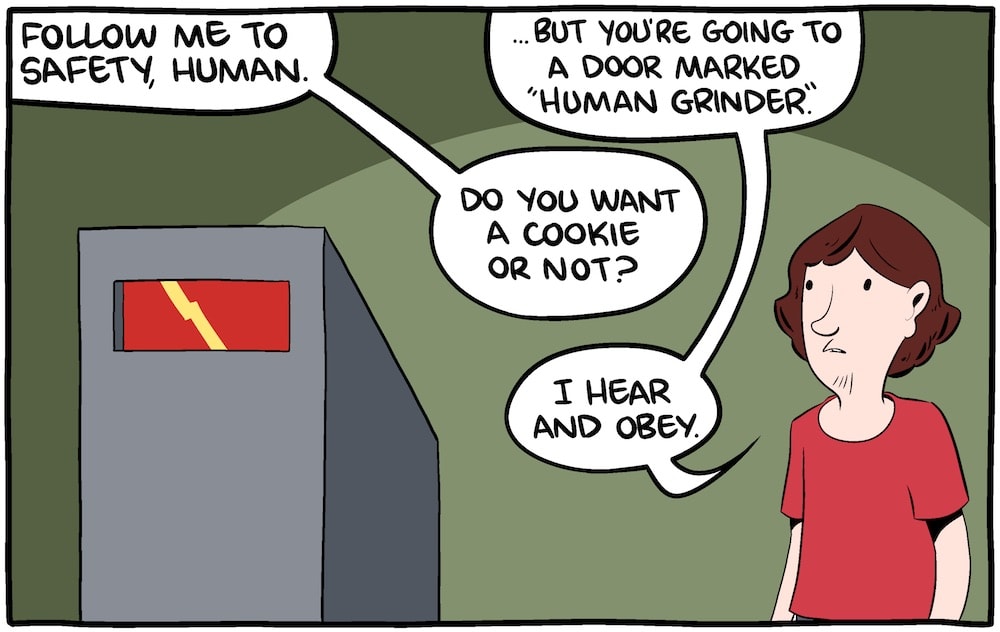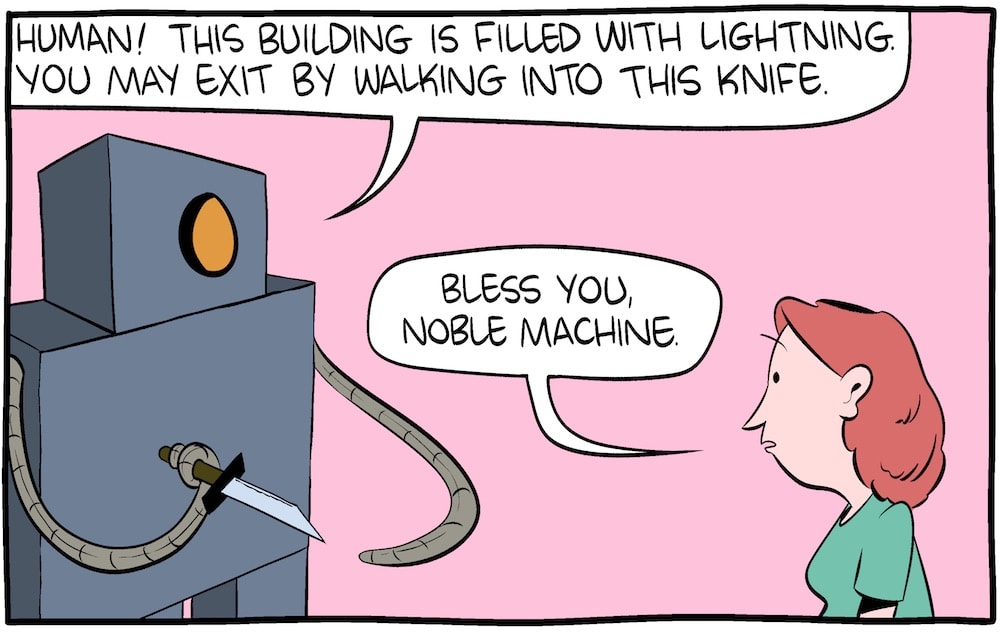If A Robot Offers You A Cookie…
Authors Zach and Kelly Weinersmith examine the evolving nature of human-robot interactions.
The following is an excerpt from Soonish: Ten Emerging Technologies That’ll Improve and/or Ruin Everything by Kelly Weinersmith and Zach Weinersmith.

Soonish: Ten Emerging Technologies That'll Improve and/or Ruin Everything
We have an abiding belief that enormous swarms of autonomous robots will be just fine. After all, we know many people in this field and several of them seem nonevil.
But some people have begun to wonder exactly what the nature of the human-robot interaction will be as robots become a more frequent companion, not just in industry, but in everyday life. We came across three recent articles that gave us pause.
In one case, a Russian start-up called Promobot created a robotic assistant that keeps escaping from its human overlords. The Promobot IR77 was designed to learn from its environment and to remember human faces. So far, it has managed to escape the building twice. This is a bit of a problem because the robot is designed to assist humans, such as elderly people in nursing homes, and it’s just not going to be superhelpful if the little guy keeps running off in search of freedom and adventure.
Also, it makes us wonder if our coffee machine would rather be running free than serving us faithfully. Not that it’d change our behavior, but then maybe this is just the sort of thing that’ll cause the Robot Uprising in 2027.
Another study was done by Serena Booth, a student at Harvard, who created a robot called Gaia. Gaia was a simple remote-controlled robot that Serena manipulated in secret. It would approach individuals and groups asking to be allowed into dorms.
According to Ms. Booth, there were least three reasons why Harvard students should have known better than to let the robot into the building: “The first is privacy. The robot could be taking photos of students. That’s a huge problem we have at Harvard. A lot of tourists will come and put cameras right up to our dorm-room windows, so it’s something the students here are very aware of. The second is theft. My experiments took place a week after we’d seen a slew of dorm-room thefts. The administration had e-mailed every single student to tell them to be especially careful with their private property just a week before. The third dimension is the most dramatic. People are worried that robots could be carrying bombs and that’s not an unfounded threat here. We’ve had three major bomb threats over the past year. It’s something that Harvard students are very aware of as well.”
When Gaia asked individual students for access to a building, it was only allowed in 19% of the time. But when Gaia approached groups, it got in 71% of the time. So pay attention, robotic readers: People get stupid in groups.
But then Gaia happened on something a bit more terrifying. Ms. Booth ran a test in which Gaia went up to lone individuals, pretending to be a cookie delivery robot. In this case, the robot was let into the building 76% of the time. And these are Harvard students. And, according to Ms. Booth, the cookies were just okay-tasting grocery store cookies (though they were disguised in a box from a more upscale cookie store).
[Can you feel me now? The science behind haptic technology.]
Perhaps the scariest story we encountered involved students blindly following robots they were led to believe were defective during emergency situations. Dr. Paul Robinette (a graduate student at the Georgia Institute of Technology at the time) created an “emergency guide robot” that first led students to a room where they were supposed to fill out a survey. In some cases, the robots led the students straight to the survey room. In other cases, the robot first went into a wrong room, circled it a few times, and then went to the correct survey room.
Next, the researchers simulated an emergency by releasing smoke in the building, which set off the fire alarms, and waited to see if the students would follow the emergency guide robot out of the building or would leave independently through the entrance into which they had entered the building.
Nearly all students followed the robot to an exit rather than taking the path with which they were familiar. This was already a little surprising, as the robot seemed to be moving pretty slowly in the video we watched. Plus, some of the participants had previously seen the robot waste time by circling around in an incorrect room. Yet still they followed.

More surprising though, was that students followed the robot even when they were led to believe the robot was broken. After the robot spun in circles and then guided the participant to a corner rather than the appropriate survey room, and when a researcher subsequently came out to apologize for the broken robot, the students still followed the robot during the simulated emergency.
In another experiment, two of six students were told a robot was broken, but still followed it when during a fire alarm it told them to go into a dark room mostly blocked by furniture. Two of the other students stood by the robot, waiting for it to give them different instructions, before finally being retrieved by the experimenters. Only two of the six students decided a broken robot was a bad bet, and evacuated out the doors through which they had entered the building.
To recap: (1) Intelligent robots appear to develop a spontaneous dislike for their human creators, (2) the best and brightest American students will trust any robot that’s willing to spring for grocery store snickerdoodles, and (3) these future stewards of the Republic would probably stand in a gasoline fire if a clearly broken robot told them it was a good idea.
In short: In the future, if a robot hands you cookies and tells you where to go, make sure to savor them.

Adapted from Soonish: Ten Emerging Technologies That’ll Improve and/or Ruin Everything by Kelly and Zach Weinersmith (October 17; Penguin Press). Copyright © 2017 by Kelly and Zach Weinersmith.
Zach Weinersmith is creator of Saturday Morning Breakfast Cereal, founder of BAHFest, and author of Augie and the Green Knight (Breadpig, 2015) based in Houston, Texas.
Kelly Weinersmith teaches at Rice University and is the co-author of Soonish: Ten Emerging Technologies That’ll Improve and/or Ruin Everything.